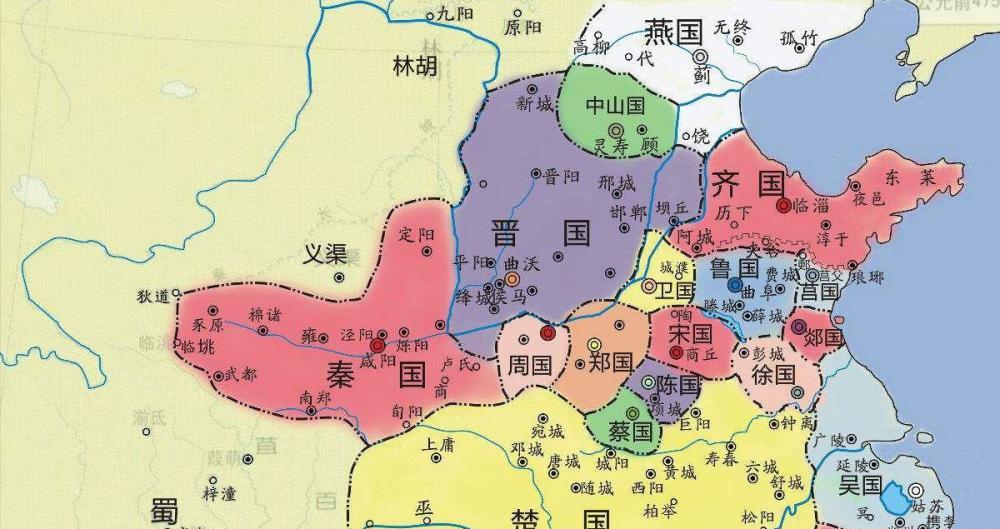According to historical records, in ancient times, there were thousands of Fang states in the land of China, and after hundreds of years of "big eating small" mergers, there were only 108 countries in the history books in the Spring and Autumn Period, and in the middle of the Warring States period, there were only a handful of more than ten countries left.
In addition to the seven first-class foreign countries such as Qin, Zhao, Wei, and Qi, there are also second-rate small countries such as Song and Wei that are also included in the "History of the Shijia". However, there was such a strange small country, with a territory of only 500 miles, but it was able to kill four parties, seize a large amount of territory from the three major powers of Yan, Zhao and Qi, and claim the king at the same time as the powerful state of Wei, no one can say where it came from, even Sima Qian did not write a separate biography of it because of insufficient information when he wrote the historical records.

This country is Zhongshan.
The name ZhongshanGuo first appeared in the "Left Biography": "Zhongshan, Xianyu", Xianyu is a branch of Bai Di, but this does not mean that Zhongshan Kingdom belongs to foreign tribes, because under the influence of YixiaGuan, everything outside the Central Plains is called Yidi Rongman, and Yin Shang was also called Dongyi before entering Huaxia.
Although it is classified as "Yidi", but the Zhongshan state is not barbaric and backward, the Warring States Policy once recorded, "Zhongshan specializes in benevolence and righteousness, noble Confucianism", the evil thing is that such a country that respects Confucianism is very belligerent, and the combat effectiveness is very explosive, in 376 BC, Yan and Zhao joint crusade, not only did not take the slightest advantage, the main general of the Yan army was even killed.
In 332 BC, the Zhongshan State even took the initiative to send troops to attack Zhao, and bingfeng pointed directly at Yanyi, and the Zhao State was shaken. The direct reason for Zhao Wuling's king Hufu riding and shooting was to "repay the grievances of Zhongshan." However, it is such a Zhongshan kingdom, which occupies one-ninth of the world and is known as the eighth male of the Warring States, but it has left a mystery for future generations for 2300 years: what kind of country is Zhongshanguo?
In the 1970s, when the Hebei Archaeological Team conducted an archaeological survey in Sanji Village, Pingshan County, some farmers reported that when hoeing the land before, they had dug up a strange stone that was 90 long, 50 wide and 40 centimeters thick, and it was carved with unknown characters.
According to the interpretation of Beijing experts, the inscription on this strange stone is a small seal, with a total of 19 characters: "The overseer has a courtier, the old general Man who guards the hill, and the sage who dares to pay homage to the queen", which means that the old general Man who supervised the fishing and gardening (for the great king) and guarded the mausoleum paid homage to the later sages.
It was finally confirmed that this strange stone was carved in the Zhongshan Guoshouqiu stone of the Warring States period, and it is also the earliest stone carving found in China so far. There is no doubt that the records on the stone inscriptions have made the Zhongshan Kingdom, which disappeared for 2200 years, come out of nowhere.
Sure enough, after nearly 30 years of archaeological excavations, a total of six Zhongshan national tombs were found in Sanji Village, and a large number of national treasure-level cultural relics were unearthed. These range from pottery using polished and press-scribing techniques to the copper plate of the mega domain map, the world's earliest text-labeled map.
The high level of craftsmanship and the refinement of production prove that Zhongshan Country has a profound cultural heritage, and the Shouqiu stone carvings using small seal fonts also prove that the cultural appearance of Zhongshan Country is basically the same as that of the Central Plains countries, making up for the shortcomings of historical records.
So the question is, what does such a country in the cracks between the warring states and the land is barren rely on to support years of war?
The "Warring States Policy" once mentioned that Zhongshan "relied on the opportunity to profit and eat" (doing business). In the archaeological excavations, the Tomb of the King of Zhongshan has also unearthed a large number of sword coins and iron basins, copper pots, bronze ware, and wrong gold and silver ware from Yan and Zhao, and it is obvious that what supported the Southern Expedition and Northern War of the Zhongshan Kingdom was actually a developed commodity trading.
More amazing discoveries are yet to come. Four burial pits have been excavated near the tomb of King Zhongshan, one of which is a burial ship pit, with three large ships juxtaposed in the southeast of the south chamber, a small boat in the north and south, and a wreckage of the main ship found in the north chamber, which shows that the Zhongshan Kingdom, which is located in the inland of the north, actually has a boat division system. This also subverted the traditional impression that only southern princely states such as Chu and Wu had boat masters.
It is not difficult to understand why the Zhongshan Kingdom, which has few people in the land, has been able to compete with Qi Jin (Zhao) for hundreds of years.